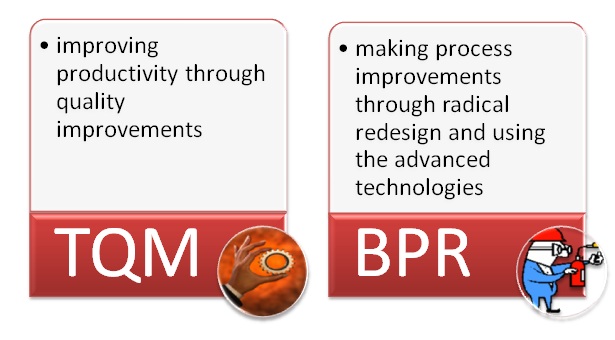Difference Between TQM and BPR
TQM vs BPR
Since TQM and BPR concepts have a cross-functional relationship, it is helpful to know the difference between TQM and BPR for a better understanding of these concepts. TQM, an acronym of Total Quality Management, is concerned about improving the productivity through quality improvements while BPR, an acronym of Business Process Re-engineering, is concerned about making process improvements through radical redesign and use of advanced technologies. Both these concepts are related to improving the efficiency in an organization. This article outlines the two concepts, TQM and BPR, and analyzes the difference between TQM and BPR.
What is TQM?
Total quality management (TQM) is a management philosophy practiced in many organizations, focusing on continuously improving the quality of its products and services in order to fulfill the customer expectations without influencing the ethical values. Therefore, everybody who is related to the organization from top to bottom has a huge responsibility in providing quality products or services.
In order to achieve TQM by fulfilling the requirements of the customers, one needs to be thoroughly concerned about the following principles.
• Necessity of producing quality output in the first time.
• Focusing on satisfying the customer expectations.
• Following a strategic approach for continuous improvements.
• Encouraging mutual respect and teamwork.
Benefits of TQM
Using the TQM philosophy ensures the following results:
• Organization becomes more competitive.
• Helping to establish a new culture which enables growth and long-term success.
• Creates a productive working environment in which everyone can succeed.
• Helps to reduce stress, waste and defects.
• Helps to build partnerships, teams and co-operation.

What is BPR?
Business Process Re-engineering (BPR) results in changes among the structures and processes within the business environment. Therefore, there may be technological advancements and human resource replacements with the automation techniques which will increase the efficiencies and the productivity of the organizations. These would result in increasing the flexibility and adaptability to the rapid changes in the competitive business environment.
Business processes can be divided into three elements as inputs, process and outputs. The BPR is related to the processing element in order to reduce the cost and improve the delivery time. According to Hammer Champy in 1993, BPR is the fundamental rethinking and radical design of the business processes to achieve improvements within performances, cost, quality, service and speed.
Objectives of BPR
The main objectives of BPR include the following factors:
• Customer focus -The main objective of BPR is to increase the level of customer satisfaction.
• Speed – With the use of advanced technologies, the processing speed is expected to be improved as most of the tasks are automated.
• Compression – It explains the ways of reducing the cost and capital invested in primary activities, throughout the value chain.It can be done by combining the interrelated activities or by performing parallel activities in a particular process.
• Flexibility – It is ab out the adaptive processes and structures used to changing conditions and competition.By being closer to the customer, the company would be able to develop the awareness mechanisms to tackle the areas that require improvements .
• Quality – The level of quality can always be maintained with the expected levels of standards and can be monitored by the processes.
• Innovation – Leadership through innovation provides changes in the organization to achieve competitive advantage.
• Productivity-It can be improved drastically with effectiveness and efficiency.
What is the difference between TQM and BPR?
• TQM and BPR have a cross-functional relationship. TQM is concerned about improving productivity through quality improvements while BPR is about making process improvements through radical redesign and use of advanced technologies.
• TQM is focusing on continuous improvements while BPR is concerned about product innovations.
• TQM emphasis on the use of statistical process control while BPR emphasis on the use of information technology.
• Both top down and bottom up approaches can be used in implementing TQM, but BPR can be implemented only through a top-down approach.
Further Reading:
ncG1vNJzZmivp6x7pbXFn5yrnZ6YsqOx07CcnqZemLyue8OinZ%2Bdopq7pLGMm5ytr5Wau27A0KZkmqaUYsO0ecGpqWg%3D